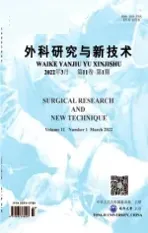Hirayama disease simple presenting proximal upper extremity muscular atrophy
2011-08-15林建华LinJianhuaDeptOrthop1stAffilHospFujianMedUnivFuzhou350005ChinOrthop2011312933
林建华(Lin Jian- hua,Dept Orthop,1st Affil Hosp Fujian Med Univ,Fuzhou 350005)…∥Chin J Orthop.-2011,31(1).-29~33
Hirayama disease simple presenting proximal upper extremity muscular atrophy
林建华(Lin Jian- hua,Dept Orthop,1st Affil Hosp Fujian Med Univ,Fuzhou 350005)…∥Chin J Orthop.-2011,31(1).-29~33
ObjectiveTo investigate the clinical features and magnetic resonance imaging(MRI)findings of patients with Hirayama disease simply presenting proximal upper extremity muscular atrophy.MethodsThree patients with Hirayama disease simply presenting proximal upper extremity muscular atrophy received cervical spine MRI on neutral and flexion position.The relationship between MRI findings and their clinical symptoms were analyzed.The outcomes were compared with those of 43 patients who were diagnosed as Hirayama disease with muscular atrophy at the hand and forearm.Results1)Clinical features:three patients were young men.The disease was characterized by unilateral weakness and atrophy of the proximal upper limbs,such as pectoralis major muscle,deltoid muscle,and biceps brachii muscle.Electromyogram(EMG)showed bilateral upper extremities neurogenic damage.2)Cervical spine MRI findings:cervical spine kyphosis without spinal cord compression was found on neutral position.On flexion position,anterior shifting of C3-C5 cervical cord and the posterior wall of dural sac were found;C4-C5 cervical cord was compressed by vertebral body or intervertebral disc or dural sac.Engorged posterior internal vertebral venous plexus were observed in epidural space.In the 43 patients who were diagnosed Hirayama disease with muscular atrophy at the hand and forearm,similar MRI findings were found,while cervical cords compression were at C6-C7 level.ConclusionHirayama disease could present as proximal upper extremity muscular atrophy and weakness,such as pectoralis major muscle,deltoid muscle,and biceps brachii muscle.Neglecting of this will result in diagnostic errors or missed diagnosis.Flexion position MRI is an important base of early diagnosis of Hirayama disease.11 refs,2 figs.
(Authors)
杂志排行
外科研究与新技术的其它文章
- Treatment for 63 cases of the elderly with choledocholith by duodenoscope
- Clinical features and surgical treatment of the coexistence of cervical,thoracic and lumber degen-erativ diss
- Free-hand cervical pedicle screw fixation for upper cervical fracture and instability
- Atlantoaxial pedicle screw system for treatment of unstable atlantoaxial dislocation post traction
- The application of C1-C2 pedicle screw internal fixation on the upper cervical diseases of chil-dren
- One stage anterior release and posterior fusion for the treatment of irreducible atlantoaxial dislocation secondary to os odontoideum
